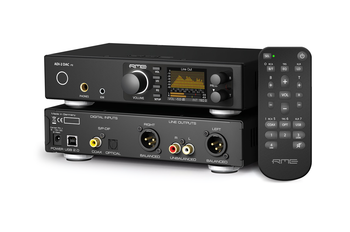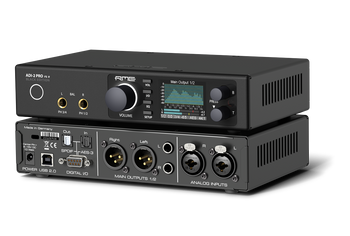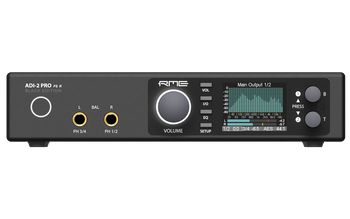Description
ADI-2/4 Pro SE
2-AD/4-DA 768 kHz, High-Performance Converter
Based on many years continued feature development of the ADI-2 Pro, RME unveils the next addition to the countless award winning ADI-2 Series. The latest masterpiece comes with a newly developed circuit board, improved specs and faster DSP for an outstanding transparent sound signature, extreme power headphone amplifiers including IEM power setting, super low noise 4.4 mm Pentaconn balanced connection, trigger out function for powering on/off external devices and finally a RIAA mode for directly digitizing vinyl discs in highest quality.
Connectivity and Features
- 2 x Phono/Line input
- 1 x ADAT I/O
- 1 x SPDIF I/O
- 1 x AES I/O
- RME USB 2.0
- 1 x Phones or Balanced Pentaconn
- 4 x Line Output
- Class Compliant Mode
- Remotе
- SteadyClock FS
- DC-coupled Outputs
RME's latest AD/DA converter is:
- A high-end AD/DA converter in professional studio quality
- A double headphone amplifier in true high-end quality
- A USB DAC like no other - the most versatile and capable one around
- A high-end AD/DA frontend and headphone amp for iPad and iPhone
- An AD/DA frontend for measurement systems at up to 768 kHz sample rate
- A multi-format converter (AES, SPDIF, ADAT) with monitoring
- An SPDIF/ADAT playback system
- A DSD record and playback solution
- A vinyl player digitizing solution on highest level
A Multitude of Devices compressed in one Housing
The ADI-2/4 Pro SE is a 2-channel analog input to digital and 4-channel digital to analog output converter in a half-rack (9.5") enclosure of 1 U height. Latest 32 bit / 768 kHz converters offer up to 123 dBA signal to noise ratio. Reference class tech specs throughout are combined with an unprecedented feature set. A powerful DSP adds all kinds of useful audio processing, including 5-band parametric EQ, fast Bass/Treble adjustment, Crossfeed, and a new concept in Loudness sound control.
The ADI-2/4 Pro includes two servo-balanced analog inputs on combo XLR / TRS jacks, two separate balanced and unbalanced outputs on XLR and TRS, two stereo Extreme Power headphone outputs on the front for easy balanced operation of all headphones, including IEMs via Pentaconn connector.
Also available are optical SPDIF I/O, which also understands ADAT, as well as coaxial SPDIF (RCA) and AES I/O (XLR) via an included breakout cable. This universal set of I/O options offers superior quality and flexible connectivity to those who take a no-compromise approach to audio.
With independent balanced outputs for Line and Phones, balanced phones no longer mutes the rear outputs. Balanced Line and Balanced Phones outputs can be used simultaneously, even with different sources/signals. The balanced TRS in the back can be fed from Line 1/2 or Phones 3/4 signal path, perfect for handling insert effects during the mastering process.
A high resolution IPS panel for the graphical operation surface eases operation even more, and displays further functions provided by the DSP, namely Peak level meters, a 30-band analyzer in DIGICheck biquad filter technology, and a State Overview screen listing the current states of SPDIF, AES, USB and clock.
The USB 2.0 port is fully Class Compliant (UAC 2.0) a standard that is natively supported by operating systems like iOS, macOS, Linux and Windows 10 (since 1709), and is also used for firmware updates. Including an external switched power supply with lockable connector, the ADI-2/4 Pro can be easily powered from battery, opening up mobile applications as well as galvanically isolated use cases.
As a computer interface the ADI-2/4 Pro offers a stereo (2 in / 2 out) and a multichannel mode (6 in / 8 out). Compatibility with macOS comes right out of the box. Under Windows the ADI-2/4 Pro uses RME's MADIface series driver, for full WDM and ASIO compatibility and highest performance.
Extreme Power Headphones - The new Reference in Accuracy and Dynamic Range
RME’s developed Extreme Power headphone stage is now further improved and delivers incredible more powerful headphone outputs (2.1 Watts unbalanced, 3.4 Watts balanced at 32 Ohms, per channel). With a Special IEM mode, the Lower noise Extreme Power design adds additional IEM power states (High power, Low power, IEM) for full IEM compatibility.
All three phones outputs feature mute relay, over-current detection, DC protection, plug detection and DSP control, like auto assigning volume, volume ramp up, auto balanced mode, dual phones mode, user interaction at overload detection, and low impedance level meter auto scaling.
RME’s latest True Balanced mode realizes balanced phones operation independent from the XLR outputs. The device now features 2 balanced input channels and 4 balanced output channels. Balanced headphones only use DAC channels 3/4 and the rear outputs can still output an independent signal via DAC 1/2. In True Balanced mode the ADI-2/4 Pro SE’s maximum output level rises to +7 dBu for IEM, +13 dBu for Low Power, +25 dBu for High Power. The signal to noise ratio stays unchanged.
Specifications
Analog Inputs
XLR/TRS
- Input: XLR and 6.3 mm TRS jack, servo-balanced
- Input impedance @ 1 kHz, balanced: 90 kOhm, unbalanced: 45 kOhm
- Input sensitivity switchable +24 dBu, +19 dBu, +13 dBu, +7 dBu, +1 dBu @ 0 dBFS
- Digital Trim Gain range: 0 dB up to +6 dB, in steps of 0.5 dB
- Signal to Noise ratio (SNR) @ +13/19/24 dBu: >120 dB (AES17), >123 dBA
- Signal to Noise ratio (SNR) @ +7/+1 dBu: >120 dB (AES17), 123 dBA
- Frequency response* @ 44.1 kHz, -0.1 dB: 0.4 Hz – 20.4 kHz
- Frequency response* @ 96 kHz, -0.5 dB: 0.2 Hz – 45.5 kHz
- Frequency response* @ 192 kHz, -1 dB: 0.15 Hz – 90.9 kHz
- Frequency response* @ 384 kHz, -1 dB: 0.15 Hz – 182 kHz
- Frequency response* @ 768 kHz, -1 dB: 0.15 Hz – 348 kHz
- THD @ -0.5 dBFS: > -130 dB, 0.0000316 %
- THD+N @ -0.5 dBFS: -119 dB, 0.000112 %
- Channel separation: > 130 dB @ 1 kHz
* DC Filter None. With Filter RME @ -1 dB: < 0,5 Hz
RIAA Mode via TS
- RIAA deviation 20 Hz – 20 kHz: < ±0.05 dB
- Input impedance: 45 kOhm @ 1 kHz, input capacitance 150 pF
- Sensitivity: +14 dB: 20 mV, +20 dB: 10 mV, +26 dB: 5 mV
- Sensitivity: +32 dB 2.5 mV, +38 dB: 1.25 mV
- Additional 0 to +6 dB Gain in steps of 0.5 dB via Trim Gain
- Maximum input level @ +14 dB: 114 mV, -16.6 dBu
- Maximum input level @ +20 dB: 57 mV, -22.6 dBu
- Maximum input level @ +26 dB: 28.4 mV, -28.7 dBu
- Maximum input level @ +32 dB: 14.3 mV, -34.7 dBu
- Maximum input level @ +38 dB: 7.2 mV, -40.6 dBu
- Digital headroom in all Gains, related to sensitivity: 15 dB
- Signal to Noise Ratio (SNR), 20 Hz-20 kHz, +14/20 dB Gain: 88 dB, 92 dBA
- Signal to Noise Ratio (SNR), 20 Hz-20 kHz, +26 dB Gain: 80.5 dB, 85 dBA
- Signal to Noise Ratio (SNR), 20 Hz-20 kHz, +32 dB Gain: 74 dB, 78.5 dBA
- Signal to Noise Ratio (SNR), 20 Hz-20 kHz, +38 dB Gain: 68 dB, 73 dBA
- THD+N, 20 Hz-20 kHz, +14/+20 dB: -88 dB, 0.004 %
- THD+N, 20 Hz-20 kHz, +26 dB: -81.5 dB, 0.0084 %
- THD+N, 20 Hz-20 kHz, +32 dB: -74 dB, 0.019 %
- THD+N, 20 Hz-20 kHz, +38 dB: -69 dB, 0.035 %
Analog Outputs
1/2 XLR
- Maximum Output Level: +26.5 dBu @ 0 dBFS
- Output level switchable +24 dBu, +19 dBu, +13 dBu, +7 dBu, +1 dBu @ 0 dBFS
- Signal to Noise ratio (SNR) @ +7/+13/19/24 dBu: 120 dB (AES17), 123 dBA
- Signal to Noise ratio (SNR) @ +1 dBu: 119 dB (AES17), 120 dBA
- Frequency response @ 44.1 kHz, -0.1 dB: 0 Hz – 21 kHz
- Frequency response @ 96 kHz, -0.5 dB: 0 Hz – 44.9 kHz
- Frequency response @ 192 kHz, -1 dB: 0 Hz – 90 kHz
- Frequency response @ 384 kHz, -1 dB: 0 Hz – 181 kHz
- Frequency response @ 768 kHz, -3 dB: 0 Hz – 285 kHz
- THD @ 0 dBFS: < -120 dB, 0.0001 %
- THD+N @ 0 dBFS: -116 dB, 0.00016 %
- Channel separation: > 130 dB
- Output impedance @ 1 kHz @ +24/+19/+13 dBu: 213 Ohm
- Output impedance @ 1 kHz @ +7/+1 dBu: 113 Ohm
1/2 TS (rear)
As output XLR, but:
- Output: 6.3 mm TRS jack, impedance-balanced
- Maximum output level: +21.5 dBu @ 0 dBFS
- Signal to Noise ratio (SNR) @ +19/13 dBu: 120 dB (AES17), 123 dBA
- Signal to Noise ratio (SNR) @ +7 dBu: 119 dB (AES17), 121 dBA
- Signal to Noise ratio (SNR) @ +1 dBu: 118 dB (AES17), 118 dBA
- Output impedance @ 1 kHz: balanced 213 Ohm, unbalanced 106 Ohm
Phones 1/2, Phones 3/4
As Output 1/2 TRS, but:
- Output: 6.3 mm TRS stereo jack, unbalanced
- Maximum output level: +21.5 dBu @ 0 dBFS
- Output impedance: 0.1 Ohm
- Signal to Noise ratio (SNR) @ +19 dBu (Hi-Power): 120 dB (AES17), 122 dBA
- Signal to Noise ratio (SNR) @ +7 dBu (Lo-Power): 119 dB (AES17), 121 dBA
- Signal to Noise ratio (SNR) @ +1 dBu (IEM): 118 dB (AES17), 120 dBA
- Output level at 0 dBFS, Ref Level +19 dBu, load 100 Ohm or up: +21.5 dBu (9.2 V)
- Minimum load impedance IEM @ +1 dBu: 4 Ohm
- Minimum load impedance Lo-Power @ +7 dBu: 8 Ohm
- Minimum load impedance Hi-Power @ +19 dBu: 24 Ohm
- THD @ +20 dBu, 32 Ohm load (1.9 Watts): -124 dB, 0.000057 %
- THD+N @ + 20 dBu, 32 Ohm load (1.9 Watts): -118 dB, 0.00011 %
- Max power @ 0.001% THD: 2.1 W per channel
- Channel separation 20 Hz – 20 kHz: 80 dB @ 32 Ohm
Balanced Phones mode
As before, but:
- Maximum output level: +27.5 dBu (18.4 V) @ 0 dBFS
- Output levels switchable: IEM +7 dBu, Lo-Power +13 dBu, Hi-Power +25 dBu
- Output levels switchable: IEM 1.73 V, Lo-Power 3.46 V, Hi-Power 13.8 V
- Output impedance: 0.2 Ohm Signal to Noise ratio (SNR) @ +25 dBu: 120 dB (AES17), 122 dBA
- Signal to Noise ratio (SNR) @ +13 / +7 dBu: 119 dB (AES17), 121 dBA
- Minimum load impedance IEM @ +7 dBu: 8 Ohm
- Minimum load impedance Lo-Power @ +13 dBu: 12 Ohm
- Minimum load impedance i Hi-Power @ +25 dBu: 40 Ohm
- Max power @ 0.001% THD: 4 W per channel Channel separation: > 130 dB @ 1 kHz
Digital Inputs
General
- Lock Range: 28 kHz – 200 kHz
- Jitter suppression: > 50 dB (> 1 Hz)
- Accepts Consumer and Professional format
AES/EBU
- 1 x XLR, transformer-balanced, galvanically isolated, according to AES3-1992
- Input sensitivity 1.0 Vpp
SPDIF coaxial
- 1 x RCA, transformer-balanced, according to IEC 60958
- High-sensitivity input stage (< 0.3 Vpp)
- AES/EBU compatible (AES3-1992)
SPDIF optical
- 1 x optical, according to IEC 60958
- ADAT compatible
Digital Outputs
AES/EBU
- 1 x XLR, transformer-balanced, galvanically isolated, according to AES3-1992
- Output level 2.7 Vpp
- Format Professional according to AES3-1992 Amendment 4
- Single Wire mode, sample rate 28 kHz up to 200 kHz
SPDIF coaxial
- 1 x RCA, according to IEC 60958
- Output level 0.75 Vpp
- Format Consumer SPDIF according to IEC 60958
- Single Wire mode, sample rate 28 kHz up to 200 kHz
SPDIF optical
- 1 x optical, according to IEC 60958
- Format Consumer (SPDIF) according to IEC 60958
- Sample rate 28 kHz up to 200 kHz
Digital
- Clocks: Internal, AES In, SPDIF In, ADAT In
- Jitter suppression of external clocks: > 50 dB (> 1 Hz)
- Effective clock jitter influence on AD and DA conversion: near zero
- PLL ensures zero dropout, even at more than 100 ns jitter
- Additional Digital Bitclock PLL for trouble-free varispeed ADAT operation
- Supported sample rates for external clocks: 32 kHz up to 200
- Internally supported sample rates: 44.1 kHz up to 768 kHz
General
- Included power supply: external switching PSU, 100 - 240 V AC, 3.3 A, 40 Watts
- Standby power consumption DC 12 V: 170 mW
- Standby power consumption AC 230 V: 280 mW
- Idle power consumption: 14 Watts, Max. power consumption: 30 Watts
- Idle current at 12 V: 1.16 A
- Dimensions (WxHxD): 215 x 44 x 160 mm (8.5" x 1.73" x 6.3")
- Weight: 1.2 kg ( 2.2 lbs)
- Temperature range: +5° up to +40° Celsius (41° F up to 112°F)
- Relative humidity: < 75%, non condensing














